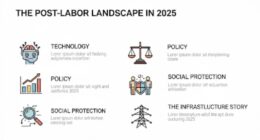Quantum mechanics tends to conjure images of abstruse equations and Schrödinger’s cat. Yet some of the most significant advances in computing and sensing are being built on those very concepts. In early August 2025, researchers from Yonsei University and Seoul National University directly measured quantum distance — technically known as the quantum metric tensor — in a real material for the first timeprnewswire.com. That might sound like a footnote to physics aficionados, but it has far‑reaching implications for AI hardware, sensors and secure communications.
What is “quantum distance” and why should we care?
Every physical system described by quantum mechanics exists in a superposition of states. The quantum metric tensor measures how similar those states are: a value of one means two states are identical; zero means they are oppositesprnewswire.com. In practical terms, this “distance” affects how accurately a quantum computer performs calculations, how robust it is to errors and even how electrons flow through exotic materials. Until this summer, no one had managed to extract the full tensor from electrons in a solid.
The breakthrough came by firing polarised synchrotron light at black phosphorus, a two‑dimensional material with a simple lattice structure. By analysing the resulting photoelectrons with angle‑resolved photoemission spectroscopy (ARPES), the Korean‑led team reconstructed the momentum‑dependent “pseudospin” textures of the electrons and, from that, the quantum metricrdworldonline.com. Professor Keun Su Kim likened the achievement to architecture: without precise measurements, buildings collapse; without precise quantum distances, quantum technologies falterprnewswire.com.
Why black phosphorus matters
Black phosphorus is one of the more exciting cousins of graphene. Its layered structure yields high carrier mobility (around 1,000 cm²/V·s along one axis) and a tunable band gap from 0.3 eV to 2 eV depending on thicknessrdworldonline.com. These traits make it ideal for transistors, photodetectors and optical modulators. Researchers at Berkeley Lab recently showed that few‑layer BP can emit bright mid‑infrared light even when the surface oxidises, hinting at applications in night vision, spectroscopy and gas sensingnewscenter.lbl.gov. BP quantum dots have even been used as saturable absorbers for ultrashort‑pulse lasers in the ultravioletfrontiersin.org.
That combination of performance, tunability and integrability is why BP served as the testbed for measuring quantum distance. By understanding its quantum geometry, engineers can design better BP‑based chips and sensors — and use BP as a calibration standard for other quantum materials.
The big picture: quantum geometry meets AI hardware
As generative AI models balloon into hundreds of billions of parameters, computing hardware becomes a bottleneck. Silicon‑based processors are hitting physical limits; quantum computing offers an alternative, but only if qubits can be controlled and error‑corrected effectively. The quantum metric tensor directly influences error rates and fault tolerancerdworldonline.com. Measuring it in real materials opens a path to tailoring qubit architectures — superconducting, photonic or topological — for optimal performance.
What’s more, quantum geometry appears in a host of phenomena such as flat‑band superconductivity and fractional quantum Hall statesarxiv.org. That means controlling quantum distance could enable high‑temperature superconductors, more efficient quantum sensors, and perhaps new device classes that blur the line between processor and memory. In other words, this isn’t just fundamental physics; it’s the foundation of next‑generation computing.
South Korea’s quantum strategy
South Korea is aggressively positioning itself in this space. The government’s Quantum Technology Promotion Act and the National Strategic Plan for Quantum Science and Technology set targets of building a 1,000‑qubit quantum computer, a 100 km quantum internet, and GPS‑free quantum navigation sensors by the early 2030spostquantum.com. A dedicated ₩1 trillion innovation fund and ₩20 billion annual support for quantum start‑ups were announced in March 2025postquantum.com. The ministry also approved a ₩645 billion (~£370 million) programme to develop superconducting qubits with error correction and new quantum algorithmsquantumzeitgeist.com.
On the hardware side, European firm IQM installed its first Asia‑Pacific quantum computer (a 5‑qubit system) at Chungbuk National University in May 2025 and is opening a Seoul officemeetiqm.com. Universities are racing to train talent: POSTECH’s graduate school aims to produce 180 quantum specialistspostquantum.com, while Yonsei partners with IBM to access a 127‑qubit processorpostquantum.com. These steps could give South Korea an edge in quantum computing and, by extension, AI hardware.
Quantum metrology is already transforming industry
Beyond computing, quantum measurements are entering the industrial mainstream. McKinsey projects that the quantum sensing market — covering magnetometers, gravimeters, inertial sensors and biosensors — will reach roughly US$1 billion by 2030mckinsey.com. Potential applications include:
- Wearable medical diagnostics: arrays of neutral‑atom or diamond NV‑centre sensors could map brain activity without MRI machinesmckinsey.com.
- GPS‑free navigation: quantum accelerometers offer accurate positioning in tunnels, underwater or spacemckinsey.com.
- Chip manufacturing: quantum sensors can detect defects in integrated circuits during production, improving yieldmckinsey.com.
- Resource exploration: gravimeters and magnetometers map subterranean minerals and groundwatermckinsey.com.
An international team recently used entangled photons to push measurement precision to fundamental limits on the Fraunhofer QSystemOne quantum computeruni-jena.de. They believe similar techniques could enhance 6G radio technology and biomedical imaginguni-jena.de. This cross‑pollination — where quantum computers become measurement tools — underscores why understanding quantum geometry matters for industry.
Takeaways for the AI community
- Hardware matters: progress in AI is linked to advances in physics and materials science. Measuring quantum distance in black phosphorus doesn’t just earn a Nature paper; it paves the way for new qubit designs and sensors that could power AI accelerators.
- National strategies shape the field: South Korea’s investment shows how governments can accelerate quantum technology. By funding hardware, talent and testbeds, the country aims to leapfrog into the top tier of quantum nationspostquantum.com.
- Sensors will reshape industries: quantum sensors are mature compared with quantum computers and will likely see broad adoption first. Expect quantum sensing to quietly transform healthcare, navigation and chip production within this decade.
As AI researchers and builders, we often focus on algorithms, models and data. But beneath the software layer lies a world of quantum mechanical phenomena that will determine how far we can push machine intelligence. The measurement of quantum distance in black phosphorus is a reminder that the next revolution in AI hardware may come from quantum geometry — and that South Korea intends to be at its forefront.









